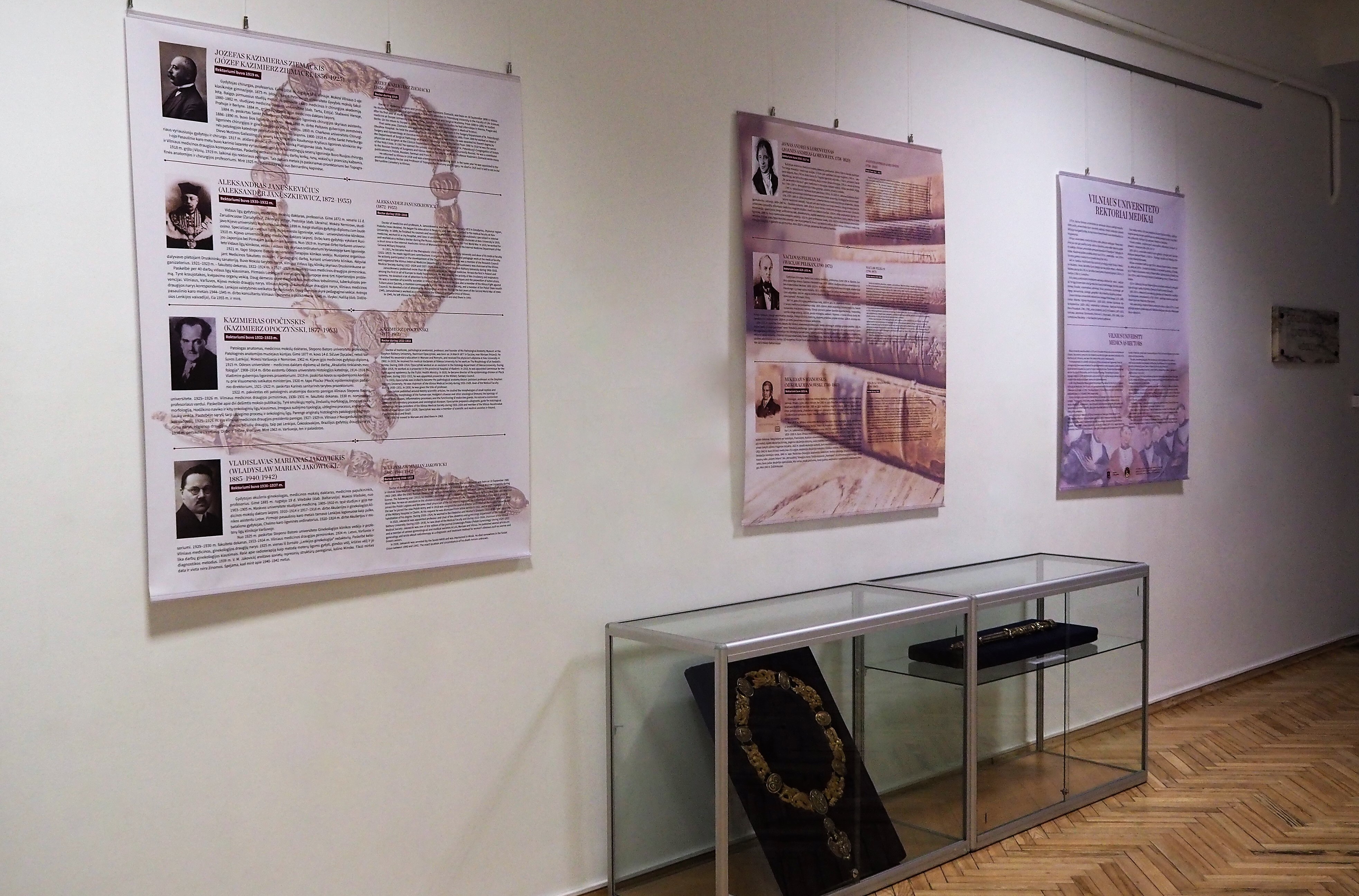 Fragment of exhibition “Rectors of Vilnius University”. Photo: VU MF
Fragment of exhibition “Rectors of Vilnius University”. Photo: VU MF
Exhibition “Rectors of Vilnius University” was opened in Faculty of Medicine on 23rd November to celebrate the 240th anniversary of the Faculty of Medicine of Vilnius University. It introduces the professors of the Faculty of Medicine of Vilnius University.
Vilnius University was founded in 1579 and is the oldest tertiary education establishment in Lithuania. For several centuries the University was the only higher education institution in the Great Duchy of Lithuania, and was the centre of the country’s intellectual life.
The development of scientific disciplines at Vilnius University was fragmented. From the very beginning there were individual faculties intended for certain disciplines, while other disciplines were included as a part of larger university divisions. The first faculties established were the Faculty of Philosophy and the Faculty of Theology. The teaching of classical languages began in 1570. Mathematics also arrived in 1570, and the natural sciences were only included in the study curriculum during the eighteenth century.
In 1641 King Władysław Waza signed the privilege of foundation for the Faculty of Law and the Faculty of Medicine. The Faculty of Law was established at the same year and the Faculty of Medicine much later in 1781. The departments of Global History and also Chemistry were established later, in 1783 and 1784, respectively.
To date, the higher education establishments are managed by the Rectors (lat. Rector:a manager). Theologians, historians, poets, rhetoricians, philosophers, mathematicians, lawyers, physicists, astronomers, musicologists, educationalists, zoologists, geographer and representatives of other scientific disciplines have been elected as rectors during the long history of the university.
Among the notable Rectors of Vilnius University are, theologian Petras Skarga (1579–1584), historian Albertas Vijūkas-Kojalavičius (1653–1655), rhetorician Kazimieras Vijūkas-Kojalavičius (1659–1661), mathematicians and astronomers—Martynas Počobutas (Marcin Poczobutt, 1780–1799), Jonas Sniadeckis (Jan Ch. W. Śniadecki, 1807–1815), lawyer Jeronimas Stroinovskis (Hieronim S. Stroynowski, 1799–1806) and following the establishment of the Faculty of Medicine, several well-known professors of this faculty are among the most notable rectors of Vilnius University.
This year, commemorating the 240th anniversary of the foundation of the Faculty of Medicine an exposition was prepared introducing the professors of our faculty who were elected as University Rectors. Some of them led the Faculty of Medicine.
The first medical professional Prof. Jonas Andrius Lobenveinas (Joanes A. Lobenwein) – was the rector in 1816-1817.
A medical surgeon Prof. VaclovasPelikanas (Wacław Pelikan) was University Rector from 1826 to 1831. He was replaced by a physiologist, obstetrician Mikalojus Mianovskis (Mikołaj Mianowski) who was elected to this position in 1831.
The traditions of Vilnius University were continued at the Stephanus Bathoreus University that was reconstituted in 1919, and continued its activities up to 1939. The university had the following Faculties: Humanitarian Sciences; Theology; Legal and Social Sciences; Mathematics and Natural Sciences; Medicine (including the Pharmacy Division, which was established in 1919); Fine arts, and Agriculture.
The medical surgeon Jozefas Kazimieras Ziemackis (Józef Kazimierz Ziemacki) became a provisional rector of the Stephanus Bathoreus University in 1919.
From 1930 to 1932 paediatrician, Professor Aleksandras Januškevičius (Aleksander Januszkiewicz) was elected as rector. In 1933 he was replaced by the pathologist anatomist, Professor Kazimieras Opočinskis (Kazimierz Opoczyński).
One of the last rectors of Stephanus Bathoreus University, (1936–1937) was a physician, obstetrician-gynaecologist, Professor Vladislavas Marijanas Jakovickis (Władysław Marian Jakowicki).
We kindly invite you to visit the exhibition on the second floor of the Faculty of Medicine of Vilnius University.
The exhibition was prepared by the Museum of Medical History
